意大利语发音第三讲
意大利语发音规则
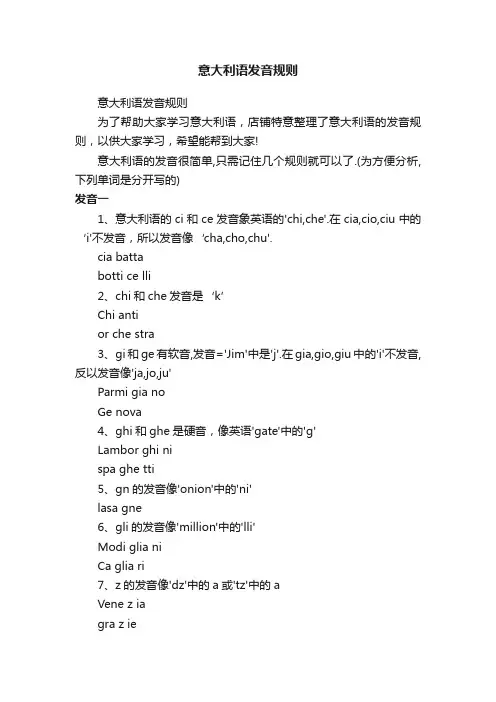
意大利语发音规则意大利语发音规则为了帮助大家学习意大利语,店铺特意整理了意大利语的发音规则,以供大家学习,希望能帮到大家!意大利语的发音很简单,只需记住几个规则就可以了.(为方便分析,下列单词是分开写的)发音一1、意大利语的ci和ce发音象英语的'chi,che'.在cia,cio,ciu中的‘i'不发音,所以发音像‘cha,cho,chu'.cia battabotti ce lli2、chi和che发音是‘k’Chi antior che stra3、gi和ge有软音,发音='Jim'中是'j'.在gia,gio,giu中的'i'不发音,反以发音像'ja,jo,ju'Parmi gia noGe nova4、ghi和ghe是硬音,像英语'gate'中的'g'Lambor ghi nispa ghe tti5、gn的发音像'onion'中的'ni'lasa gne6、gli的发音像'million'中的'lli'Modi glia niCa glia ri7、z的发音像'dz'中的a或'tz'中的aVene z iagra z ie8、zz发音='tz'pi zz apia zz a发音二(为方便分析,下列单词是分开写的)1、Sci和sce发音=‘SH’pro sc iutto火腿pi sc ina游泳池pe sc e 鱼2、请注意sche和schi有硬音‘sk‘ri schio风险bru sche tta3、Qu,du,bu,它们的发音='kw','dw','bw'que sto 这个qui这里duo mo天主教堂buo no 好4、s和 ss单个's'在词中发音像英语的'z'Co s a 什么la ca s a 房子但'ss'的发音像英语的'ss'Po ss o我可以吗ade ss o 现在5、其他的双辅音如:'rr' , 'tt',它们的'发音只有一点与单元音不同重音和语调1、一般来说,单词中倒数第二个音节是重音spa ghet tira vio li2、但也有许多例外te le fonoca meraeco no mico3、如果没有语调,词尾就要有重音centro cittàun caffè4、字母h不发音发音三1.意大利语是以元音结尾的(除了外来语,如sport,film,yogurt)armadi o壁橱lampad a 灯2、元音和元音组合要清楚地发音n oio s o , n oio s a无聊p ie d e脚3、双辅音必须发音。
意大利语学习第三课
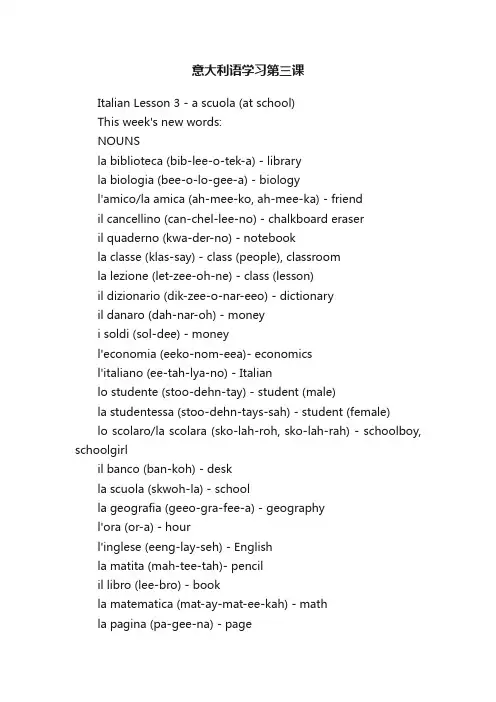
意大利语学习第三课Italian Lesson 3 - a scuola (at school)This week's new words:NOUNSla biblioteca (bib-lee-o-tek-a) - libraryla biologia (bee-o-lo-gee-a) - biologyl'amico/la amica (ah-mee-ko, ah-mee-ka) - friendil cancellino (can-chel-lee-no) - chalkboard eraseril quaderno (kwa-der-no) - notebookla classe (klas-say) - class (people), classroomla lezione (let-zee-oh-ne) - class (lesson)il dizionario (dik-zee-o-nar-eeo) - dictionaryil danaro (dah-nar-oh) - moneyi soldi (sol-dee) - moneyl'economia (eeko-nom-eea)- economicsl'italiano (ee-tah-lya-no) - Italianlo studente (stoo-dehn-tay) - student (male)la studentessa (stoo-dehn-tays-sah) - student (female)lo scolaro/la scolara (sko-lah-roh, sko-lah-rah) - schoolboy, schoolgirlil banco (ban-koh) - deskla scuola (skwoh-la) - schoolla geografia (geeo-gra-fee-a) - geographyl'ora (or-a) - hourl'inglese (eeng-lay-seh) - Englishla matita (mah-tee-tah)- pencilil libro (lee-bro) - bookla matematica (mat-ay-mat-ee-kah) - mathla pagina (pa-gee-na) - pagela carta (kar-tah) - paperla lavagna (lah-vah-nya) - chalkboardla penna (pen-nah) - penl'orologio (oh-roh-lo-joe) - clock/watchil compito (kom-pee-toh) - homeworkil tempo (tehm-poh)- timeil gesso (jehs-soh)- chalkl'università (oo-nee-ver-see-tah)- university VERBSamare - to loveascoltare (as-kohl-tah-reh) - to listen studiare (stoo-dee-ah-reh) - to study parlare (par-lah-reh) - to speak/talk chiamare (kee-ah-mah-reh) - to call ritornare (ree-tor-nah-reh) - to return lavorare (lah-voh-rah-reh) - to work INTERROGATIVESquale (kwahleh)- whichquando (kwahndo) - whenquanto(-a) (kwahnto) - how muchquanti(-as) (kwahntee)- how manydove (doh-vay) - whereperché (payr-kway)1 - whyche cosa (kay kohsah) - whatchi (kee) - whoCONJUNCTIONSperché (payr-kway)1 - becausee (ay) - andPREPOSITIONSa (ah) - at, to, the dative aADJECTIVEScorto(-a, -i, -e) (korto) - shortquarto(-a, -i, -e) (kwar-toh) - quarter (one-fourth) difficile (-i) (deef-fee-chee-lay) - difficultfacile (-i) (fa-chee-lay) - easylungo(-a, -hi, -he) - longlargo(-a, -hi, -he) - wide, broadmezzo(-a, -i, -e) (metz-zoh) - halfNumbers 100-999.999100 cento (chen-toh)101 centouno (chen-toh oo-no)102 centodue103 centotre110 centodieci120 centoventi199 centonovantanove200 duecento (doo-ay-chen-toh)201 duecentouno255 duecentocinquantacinque282 duecentoottantadue300 trecento (tray-chen-toh)400 quattrocento (kwat-troh-chen-toh)500 cinquecento (cheen-kwe-chen-toh)600 seicento (say-ee-chen-toh)700 settecento (set-tay-chen-toh)800 ottocento (ot-toh-chen-toh)900 novecento (no-vay-chen-toh)1.000 mille (mil-lay)1.001 milleuno1.010 milledieci1.100 millecento1.538 millecinquecentotrentotto1.999 millenovecentonovantanove2.000 duemila3.000 tremila9.000 novemila10.000 diecimila15.000 quindicimila27.000 ventisettemila76.000 settantaseimila99.999 novantanovemilanovecentonovantanove100.000 centomila210.005 duecentodiecimila e cinque305.111 trecentocinquemila centoundici500.000 cinquecentomila860.789 ottocentosessantamila settecentoottantanove911.222 novecentododicimila duecentoventidueNotesThere is a single word in Italian for "why" and "because", that is perché. The accent on perché, as well as on any other word in Italian, tells you that the stress is on that syllable. Accents in Italian are written only to indicate that the stress is on the last syllable (contrary to the majority of words which is stressed on the penultimate syllable). On dictionaries accents are always written on the stressed syllables, but this is not done in common writing.The letter "q" (as in quando) is always followed by an "u" and another wovel, and is pronounced "kw" (as in English "quill"). The same identical pronunciation is used for the group "cu" followed by a vowel (as in scuola). There is no rule on when to use eitherforms in writing, but it is a serious mistake to use the wrong one (in fact, writing "squola" with "q" is the prototype of mistakes in jokes). There are a few words with a double-sound (k-kw), which are always written as "cqu + vowel" (like acqua "water", pron. "ak-kwah"), with a single exception of double "q" in the word soqquadro ("sok-kwa-droh", "a mess").Regular -are (1st conjugation) verbsAll Italian verbs fall into one of three categories (conjugations) - they either end in are, ere, or ire. Within each category, there are regular and irregular verbs. Regular verbs all conjugate with a similar pattern - all the new verbs in this lesson are regular (as you'll see soon). Irregular verbs don't follow a pattern, and each verb's conjugation has to be memorized separately - the two verbs you learned in Lesson 2, essere and stare are irregular.Here are the new verbs for this lesson: amare, ascoltare, studiare, parlare, ritornare, lavorare. These are all regular -are verbs. Here are the present-tense (present indicative) conjugations of them all:io parlo ("I speak")tu parli ("you speak")lei,[lui]parla ("you (formal), [he,] she speaks")noi parliamo ("we speak")voi parlate ("you (plural) speak")essi,esse,loro parlano ("they (male), they (female). you (formal plural),speak")Regular verbs are made up of a body (parl), and a suffix (are). To conjugate regular verbs, replace the infinitive suffix (are, ere, ire) with the correct conjugation suffix from the example conjugation for parlare above. For example, take amare, andconjugate it:io amo ("I love")tu ami ("you love")lei,[lui] ama ("you (formal), [he,] she loves")noi amiamos ("we love")voi amate ("you (plural) love")essi,esse,loro amano ("they (male), they (female) you (formal plural), love")All verbs can be split into a body/suffix pair, but only regular verbs follow these patterns. There are 3 different regular-verb patterns - one for -are verbs, one for -ere verbs, and one for -ire verbs. (In the next lesson, we'll learn the rules for regular -ere and -ire verbs.) In summary, to conjugate any regular -are verb in the present (present indicative) tense, remove the -are suffix, and add one of the following (depending on who is the subject of the verb):io -otu -ilei,lui,esso -anoi -iamovoi -ateessi,esse,loro -anoHere are complete conjugations of 2 more verbs from this lesson:lavorareio lavoro, tu lavori, lei lavora, noi lavoriamo, voi lavorate, essi lavoranoritornareio ritorno, tu ritorni, lei ritorna, noi ritorniamo, voi ritornate, essi ritornanoNow that we have the conjugation for these regular -are verbs, we can make sentences with them, like this:Amo Tania. ("I love Tania")Lavora all'università. ("He works at (in) the university")Noi ascoltiamo la professoressa. ("We listen to the teacher") Essi studiano alle otto. ("The men study at 8")Esse parlano italiano. ("The women speak Italian")Io ritorno all'università alle tre. ("I return to the university at 3 o'clock")Studiate matematica ? ("Do you study math?")A - At or T o, and the dative AIn a few of the sentences above, the preposition a is used, as in Essi studiano alle otto. The preposition a translates to the English "at" or "to", depending on the sentence. The preceeding sentence ("essi studiano……") is an example of a meaning "at". The sentence io ritorno all'università is an example of a meaning "to". When the a comes before an article, as in io ritorno a la università, the a and the la combine to form alla. This is the so-called articulated preposition. Moreover, if the next noun begins with a wovel, the last vowel of the articulated preposition falls and is replaced by an apostrophe So the correct way to write the preceeding sentence is: io ritorno all'università.Note that the English "at" may translate to either a or in in Italian, depending on the sentence. In is usually used to refer to something being at something else, such as sono in università - "I'm at the university". A usually refers to a state or condition (sort of) of something, such as "at great speed", or when referring to time, such as alla una ("at one o'clock").In two more cases, the a isn't either of the above two meanings, but is used for English "to". One case is when a motionto somewhere is involved, like in "Io vado all'università" (I go to the university, the verb used is irregular). Another one is when a person or name of a place is the destination of a verb, an a is placed before the object, as in La professoressa parla agli studenti. ("The teacher talks to the students"). The preposition a is NOT needed for transitive verbs (when the object is direct, as in Io amo Tania ("I love Tania").Numbers 100 to 999.999If you've looked at the numbers in the New Words section, you may already have seen some patterns developing in Italian numbers. First, the numbers 100, 200, 300, etc., all have a similar form - cento, duecento, trecento…… If you look carefully, and remember the numbers 2 through 9, you'll see that each hundred above 100 is just "two hundred" (duecento), "three hundred" (trecento), and so on. To form numbers in between the hundreds, you use the numbers 1-99 you learned in the last 2 lessons, but add the hundreds on to the front. Eleven is undici, 111 is centoundici. Three-hundred and twenty is trecentoventi, and so on. Putting spaces between parts of a compound number is optional.Mille is Italian for 1.000. No, this isn't "one point zero zero zero zero", this is one-thousand. English uses a comma to separate thousands, millions, etc., in a number. Italian traditionally use the period (".") instead. In English, we would expect to see this number: 12,399,100. In Italian, the same number is written: 12.399.100. In much the same way, where English uses the period to denote numbers between whole numbers (as in "12.99"), Italian uses a comma ("12,99"), but this will be discussed in another lesson. In scientific practice we often use the English convention, particularly for fractionary numbers.Public administration uses the Italian convention, and this is what was taught in schools in my times.Multiples of 1000 are treated as such - 2000 is duemila, literally "two thousands". Three thousand is tremila, and so on. This pattern is the same for thousands up to 999.000 (that's nine-hundred ninety-nine thousand), so that 50.000 is cinquantamila, and 231.000 is duecentotrentunomila. Combining these two rules for numbers, we can read numbers like 123.456 (centoventitremila quattrocentocinquantasei) and 784.675 ( settecentoottantaquattromila seicentosettantacinque). So now, practice saying things like:The current year. (millenovecentonovantacinque)How many miles are on your car. (centomiaquattrocentotrentadue)The number of pages in the book you're reading. (trecentoottanta)The number of CDs and tapes you own. (duecentocinque)Your yearly salary. (uh, in Lira that will be in millions …… :-) ) Telling TimeIo ritorno in università alle tre. Telling time in Italian uses only 2 forms of the verb essere: é and sono. Italian for "it is one o'clock" is é la una. Times are always given in the feminine form because la ora ("hour", or "the time") is feminine. é la is only used if you are talking about one o'clock, since "one" is singular. For all other hours, you use sono le, as in sono le sei ("It's 6 o'clock"). Minutes are expressed as numbers after the hour, using either e or mens to represent after or before the hour, respectively. At 15 minutes before or after the hour, quarto ("a fourth") is commonly used instead of quindici ("fifteen"). Likewise, at 30 minutes after an hour, mezza ("half") is commonly used instead of trenta("thirty"). Mezza is never used with meno. Here are some examples:é la una e venti. ("It's twenty after one", literally "it's one and twenty")Sono le due meno dieci. ("It's ten before two", literally "it's two minus ten") but also é la una e cinquantaSono le quattro e un quarto. ("It's a quarter after four.")Sono le quattro meno un quarto. ("It's a quarter before four.") but also Sono le tre e tre quarti (literally, "it is three and three quarters") and Sono le tre e quarantacinque (literally, "it is three and forty-five")Sono le dieci e mezza. ("It's half past ten.")é la una meno cinque. ("It's five (minutes) to one.")To say that something is "at" a certain time, use alla or alle:A che ora é la lezione ? ("At what time is the lesson ?")La lezione é alle nove. ("The lesson is at 9 o'clock.")La lezione é alla una. ("The lesson is at one o'clock.")To ask for the time in I talian, use Che ora é ("What time is it?"). T o ask what time something happens at, use A che ora ? ("At what time……?") as in A che ora é la lezione ?, or A che ora ritorni in università ? ("What time do you return to the university?").To differentiate between AM and PM when telling time, Italian may add del mattino ("in the morning"), del pomeriggio ("in the afternoon"), della (di) sera ("in the evening") and della notte ("in the night") to describe what time of day being referred to. Usually this is clear from the context and is not specified explicitly. Another possibility is to use a 24-hour clock (this is always done officially, e.g. when calling for meetings, in train and plane timetables, etc.). So 9 o'clock PM becomes sono le nove di sera, while 9AM is sono le nove della mattina, and 5PM is sonole cinque del pomeriggio.Questions and Question WordsAsking a yes or no questionThere are many ways to ask questions in Italian, althoug there is no do-form as in English. The simplest form of a question is to use a regular sentence but either add a question mark (when written) or change the inflection (when spoken). Look at these 2 sentences:Marisa studia. ("Marisa studies.")Marisa studia ? ("Does Marisa study?")When writing a question a question mark occurs at the end of the question. When speaking, you must change the inflection of the sentence. A normal sentence ends on a low inflection, as in "maRIsa sTUdia", with capital letters denoting syllable emphasis. When asking a question, the sentence ends with a high inflection, as in "maRIsa studIA", much the same as English questions.It is also possible to change the word order when asking a question. Look at these sentences:Marisa studia italiano ?Studia italiano, Marisa ?Both these sentences say the same thing, "Is Marisa studying Italian?" The subject of the sentence, namely Marisa, can be placed or at the end of the sentence, for questions only. The second sentence may mean "is she studying Italian or another language ?"One other common way of asking a question is to add no ? or vero ? ("right?") to the end of a sentence. So the question above could also be written: Marisa studia italiano, vero ? ("Marisa is studying Italian, isn't she?" or "Marisa is studyingItalian, right?").Question wordsAll of these questions have implied either a yes or no answer - "Is Marisa studying?", "Is she studying Italian?" To ask questions that require more than a yes or no answer, you generally have to use a question word. Here is a list of some English question words and their Italian equivalents:What - che cosaWho - chiWhen - quandoWhy - perché,Which - qualeHow much - quanto(-a)How many - quanti(-e)Where - doveEach question word, or interrogative, works similarly to its English counterpart. Perhaps the easiest way to explain how to use them is through example sentences. Take a look at these: Chi é Roberto ? ("Who is Roberto?")Quando ritorna ? ("When is s/he returning?")Dove studia ? ("Where does s/he study?")Che ora é ? ("What time is it?")A che ora é la lezione ? ("At what time is the lesson?")Qual é il compito ? ("What is the homework (assignment)?") Chi é in casa? ("Who is in the house?")Dov'é la matita ? ("Where is the pencil?")Perché torni a scuola ? ("Why do you retur n to school?")In quale università studi ? ("At which university do you study?")Quanti studenti ci sono in classe ? ("How many students arethere in the classroom?")Notice the similarity between English and Italian? Try making your own questions by translating the following English sentences (note that not all of them need a question word). Type in your answer in the text box after each sentence, then press the Translations button to compare what you typed to what the right answers are. (Answers for users without forms support.) What is in the book?Where does s/he work?Who is it?Is it 2 o'clock?What do you(informal) need?Why do you love him?Test yourselfHere's your chance to see how much you know. All of these sentences you should be able to translate either from or to Italian, if you've gone through all three lessons. Type in your answer in the text box after each sentence, then press the Translations button to compare what you typed to what the right answers are. (Answers for users without forms support.)English to ItalianHello, miss, are you in school?You're the teacher, aren't you?The class is long and difficult.Is the television in the kitchen?The green chair is big.I listen to the teacher in (the) class.Are the students unpleasant?The chalkboard is dirty.I'm sorry, I don't speak English.They're Tim's papers. Italian to EnglishIl compito é difficile ? Quando é la lezione ?Parlo bene inglese e italiano. é carina ?La classe é grande e pulita Dove studiano geografia ? Chi chiamano in cucina ? Quando lavora a scuola ?é un libro di matematica.Mi serve una penna blu.。
零基础学意大利语,轻松拿下意大利语发音规则
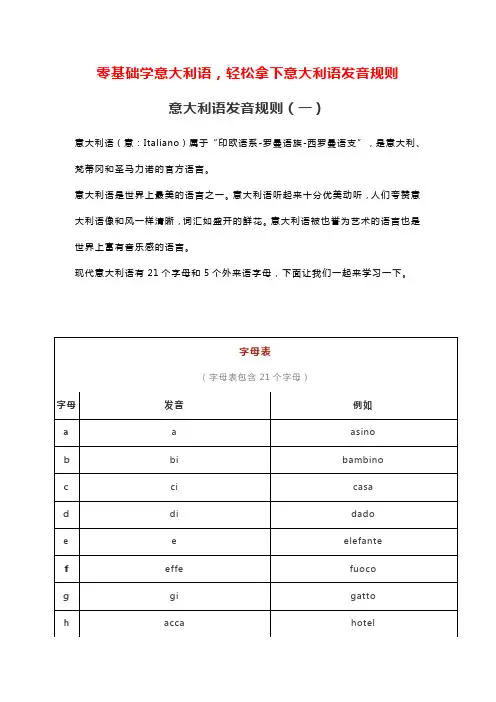
零基础学意大利语,轻松拿下意大利语发音规则意大利语发音规则(一)意大利语(意:Italiano)属于“印欧语系-罗曼语族-西罗曼语支”,是意大利、梵蒂冈和圣马力诺的官方语言。
意大利语是世界上最美的语言之一。
意大利语听起来十分优美动听,人们夸赞意大利语像和风一样清晰,词汇如盛开的鲜花。
意大利语被也誉为艺术的语言也是世界上富有音乐感的语言。
现代意大利语有21个字母和5个外来语字母,下面让我们一起来学习一下。
接下来我们来看看意大利语元音的发音规则。
发音规则元音(Vocali):a, e, i, o, uA a [a]发音方法:嘴唇自然张开,舌平伸,双唇呈椭圆形,舌尖抵下齿龈,双唇略后缩。
与汉语拼音中的a发音相近。
mamma 妈妈/ papà爸爸fama 名声/ lana 羊毛E e (è, é) [e]发音方法:嘴略呈扁平型,舌尖碰触下齿。
舌面向上颚略抬。
根据舌面上抬程度与张口大小不同,元音e又分为开口è与闭口é。
下列单词中第一个音节中的字母e发开口音,发音时张口程度较大,舌面略向上抬:bène 好/ sètte 七sède 位置/ bèllo 美丽的而下列单词中第一个音节中的字母e发闭口音,发音时张口程度较小,舌面向上抬:féde 信仰/ pépe 胡椒véla 帆/ céna 晚餐I i [i]发音方法:舌前部用力抬起,靠近前颚。
嘴形扁平,舌尖用力紧抵下齿,上下齿靠近,双唇尽量向两边拉。
与汉语拼音中的i发音相近。
li 那儿/ si 是pini 松树(复)/ nidi 窝(复)fili 线(复)/ vini 葡萄酒(复)O o (ò, ó) [ɔ]发音方法:双唇伸出呈圆形,舌部向后收缩,舌尖往下颚压,舌后部向后隆起。
根据嘴唇张伸的不同程度及发音时舌部向后收缩用力大小之不同,元音o可分为开口ò和闭口ó。
科学发音之意大利语的准确发音技巧

科学发音之意大利语的准确发音技巧作为一个意大利歌剧家,意大利语的发音是一定要牢牢掌握的,下面是店铺为大家整理的科学发音之意大利语的准确发音技巧,希望对大家有用。
一、通过强化五个元音的科学训练打好基础世界语言各有不同,不同的语言其元音也是各式各样的,即便是相同的元音在不同国家的语言中也会呈现不同的色彩。
所谓字正腔圆,其“字正”大部分是指元音正(也有辅音),即发元音的位置正;“腔圆”是指歌唱中元音状态的稳定性和饱和性。
歌唱的语言既要清楚又要美化,在字正的基础上美化了元音,腔自然就“圆”。
美声唱法中的意大利语作品演唱也讲究字正腔圆。
科学训练意大利语五个元音字母(a、e、i、o、u)的发音,可以通过下面四个学习步骤进行。
(一)用歌唱状态进行意大利语元音发音练习歌唱的状态,通常比喻为“打哈欠”的状态(指打开口腔),在念意大利语的五个元音字母“a、e、i、o、u”时,尽量在保持口腔打开的状态下利用只变换舌位的方式将五个元音念清楚,即在不影响腔体的前提下将发音做到依稀可辨。
练习夸张的元音发音时,口型变化要做到小和少。
每发一个元音,均用高位置的软起音,慢节奏,配合气息,每天练习五分钟,就会过渡自然、不留痕迹。
目的是使学生从整体上了解,在实际歌唱中意大利语基本元音的发音在口型和舌位方面的具体运动变化,熟练掌握五个基本元音之间连接的规律,为歌唱状态的连贯自如做好心理意识上的准备。
(二)用五个元音字母进行发声练习对初学者的发声练习应采用不带辅音的单元音开始。
在进行五个元音的试唱后,从学生发得最好最舒服的那个元音字母入手,而不应强迫必须先唱某个元音。
例如,某个学生“u”元音发得较好,就应从“u”元音开始练声,待这个元音歌唱状态稳定后,再向其余的元音扩展,直到五个元音字母都没有发声障碍后,再将五个元音字母放在同一条发声练习里变换使用。
排序从闭元音至开元音,更有利于学生抓住歌唱中意大利语元音字母的连接规律。
(三 )用声乐练声曲进行五个元音字母的强化训练教学中当学生练习元音的口腔状态保持以及舌位的稳定达到一定程度时,可进一步训练元音连接的连贯和自如。
最专业的老师教你怎么样学习意大利语发音三
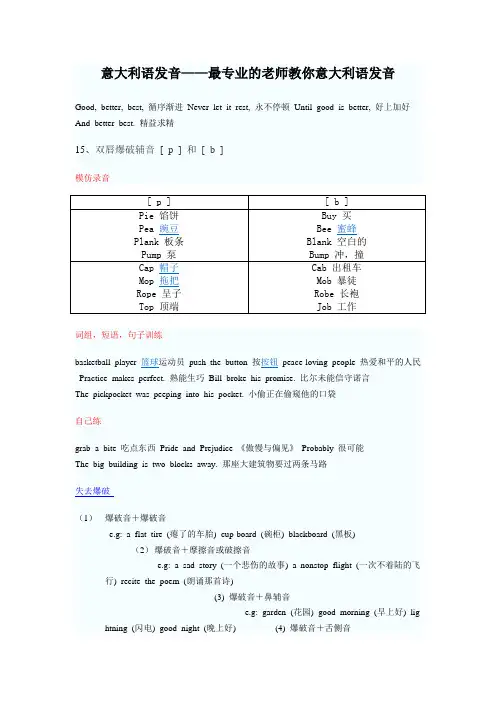
意大利语发音——最专业的老师教你意大利语发音Good, better, best, 循序渐进Never let it rest, 永不停顿Until good is better, 好上加好And better best. 精益求精15、双唇爆破辅音[ p ] 和[ b ]模仿录音词组,短语,句子训练basketball player 篮球运动员push the button 按按钮peace-loving people 热爱和平的人民Practice makes perfect. 熟能生巧Bill broke his promise. 比尔未能信守诺言The pickpocket was peeping into his pocket. 小偷正在偷窥他的口袋自己练grab a bite 吃点东西Pride and Prejudice 《傲慢与偏见》Probably 很可能The big building is two blocks away. 那座大建筑物要过两条马路失去爆破(1)爆破音+爆破音e.g: a flat tire (瘪了的车胎) cup-board (碗柜) blackboard (黑板)(2)爆破音+摩擦音或破擦音e.g: a sad story (一个悲伤的故事) a nonstop flight (一次不着陆的飞行) recite the poem (朗诵那首诗)(3) 爆破音+鼻辅音e.g: garden (花园) good morning (早上好) lightning (闪电) good night (晚上好) (4) 爆破音+舌侧音e.g: little (小) at last (最后) hard life (艰苦的生活)(2)[ s ]后面的爆破清辅音的送气问题更多文章,尽情查看:北京森淼学校(1)英语中[ s ]音后面,元音前面的爆破清辅音在实际发音中要明显减少送气,听来就像与它相对应的浊辅音,但实际上发该音声带并无明显震动。
意大利语6
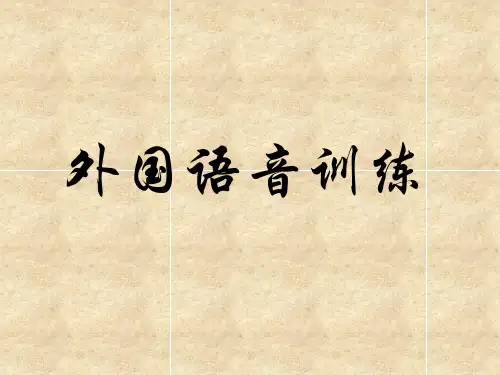
• Perla gloria d’adorarvi voglio amarivi, o luci care. Amando penero, ma sempre vamero, Si,si nel mio penare. Penero, vamero, luci care.
• Senza speme diletto vano afetto e sospeirare, ma I vostri dolci rai chi vacheggiar puo mai, e non vamare? penero,vamaro, luci care!
• 注意:若发音时嘴唇不园,就容易把 sci 发 成“稀”,把 sce 发成“谢”,把 scia 发 成“夏”,把 scio 发成“笑”,音就不纯 正了。 • 注意:sce本身就是齿槽腭音,除了scienza 科学,scienziato科学家,coscieza觉悟等 (这时scie-的发音与sce完全一样)几个词 外,齿槽腭音sce中间没有元音 i。
• 孩子们生活愉快
• Tutti devono lavorare.
• 大家都应该劳动
• Fuori tira forte il vento.
• 外面刮大风
读动词变位
vivere 生活 vivo vivi vive viviamp vivete vivono
lavorare 劳动,工作 lavoro lavori lavora lavoriamo lavorare lavorano
• 1、齿槽音(alveolare)L l • 发音方法:舌头隆起,把舌尖抵在上齿龈, 使舌头左右两边与臼齿之间产生空隙,声 带振动,气流从舌两侧流出,产生边擦音。
• Lago 湖 loto 荷花 • lira 里拉(意大利货币名称) • Luna 月亮 lupo 狼
意大利语发音技巧
意大利语发音技巧作为伟大的文艺复兴文化的媒介,意大利语曾对西欧其它语言起过深刻的影响。
29个其它国家居民使用意大利语,其中5个国家立它为官方语言。
正规意大利语是托斯卡纳的方言,发音在于意大利南半部方言之间。
下面是为大家整理的意大利语发音技巧,希望能帮到大家!意大利语发音技巧意大利语发音时,发音器官肌肉紧张度较大。
元音发音时唇形变化很明显,在练习发音时要严格按照发音部位和要求,做好唇部动作,不能随便改变唇形。
1元音发音意大利语元音发音清晰,不含糊,在发音过程中始终保持同一音质,即使在非重读时也不能弱化,每一个章节中的元音都须很清楚准确地发出来。
A a [a]:发音方法:嘴唇自然张开,舌平伸,双唇呈椭圆形,舌尖抵下齿龈,双唇略后缩。
mamma 妈妈papà 爸爸fama 声誉lana 羊毛banana 香蕉lama 刀片sala 大厅casa 房子E e 双唇略向两旁咧开,口腔张开度略小于a,舌尖碰触下齿,舌面向上颚稍抬起根据舌面上抬程度和张口大小不同,元音e又分成开口è和闭口é。
下列单词中的e发开口音,发音时张口程度比较大,舌面略向上抬:bene 好bello 漂亮lieto 高兴pieno 满的lei 她europa 欧洲pesca 桃子vento 风[é]下列单词中的e发闭口音,发音时张口训诫比较小,舌面向上抬:pepe 胡椒fede 信仰vela 帆cena 晚餐pera 梨cinese 中国人fresco 凉爽mela 苹果I i [i] 舌前部用力向硬腭抬起,舌尖抵下齿,双唇向两边拉,嘴成扁平形。
li si pino nido filo vino fine mille[ò]O o 双唇收圆,略往前伸,舌前往下压,舌后部略抬高意大利语元音发音窍门意大利语。
根据嘴唇张伸的不同程序和发音时舌部向后收缩用力大小之不同,元音o可以分为开口ò和闭口ó。
意语:意大利语元音发音
意语:意大利语元音发音本文由意大利店铺(yidali.)意大利语编辑组收集\整理\编辑,供店铺的学生学习之目的。
请大家阅读,如有任何疑问请联系我们。
意大利语字母共有21个,其中元音字母5个,辅音字母16个,另有5个外来字母。
元音的发音:意大利语发音时,发音器官肌肉紧张度较大。
元音发音时唇形变化很明显,在练习发音时要严格按照发音部位和要求,做好唇部动作,不能随便改变唇形。
意大利语元音发音清晰,不含糊,在发音过程中始终保持同一音质,即使在非重读时也不能弱化,每一个章节中的元音都须很清楚准确地发出来。
A a [a]:发音方法:嘴唇自然张开,舌平伸,双唇呈椭圆形,舌尖抵下齿龈,双唇略后缩。
mamma 妈妈papà 爸爸 fama 声誉 lana 羊毛 banana 香蕉 lama 刀片 sala 大厅 casa 房子E e 双唇略向两旁咧开,口腔张开度略小于a,舌尖碰触下齿,舌面向上颚稍抬起。
根据舌面上抬程度和张口大小不同,元音e又分成开口è和闭口é。
下列单词中的e发开口音,发音时张口程度比较大,舌面略向上抬:bene 好bello 漂亮lieto 高兴pieno 满的lei 她europa 欧洲pesca 桃子 vento 风[é]下列单词中的e发闭口音,发音时张口训诫比较小,舌面向上抬:pepe 胡椒 fede 信仰 vela 帆 cena 晚餐 pera 梨 cinese 中国人fresco 凉爽 mela 苹果I i [i] 舌前部用力向硬腭抬起,舌尖抵下齿,双唇向两边拉,嘴成扁平形。
li si pino nido filo vino fine mille[ò]O o 双唇收圆,略往前伸,舌前往下压,舌后部略抬高。
根据嘴唇张伸的不同程序和发音时舌部向后收缩用力大小之不同,元音o可以分为开口ò和闭口ó。
[ò]下列单词中的字母o发开口音,发音时嘴唇张开度大,舌后部略后缩:nonno modo notte otto buono cuore suono oggi[ó]下列单词中的字母o发闭口音,发音时嘴唇张开度小,舌后部向后收缩力大:ora loro come solo nome voce noi moltoU u [u]双唇紧缩,用力突出呈圆形,舌部使劲后缩面隆起:lupo nudo muto luna muro tutto lui uno。
意大利语语音详解
意大利语的发音意大利语字母共有21个,其中元音字母5个,辅音字母16个,另有5个外来字母。
元音的发音:阿意大利语发音时,发音器官肌肉紧张度较大。
元音发音时唇形变化很明显,在练习发音时要严格按照发音部位和要求,做好唇部动作,不能随便改变唇形。
意大利语元音发音清晰,不含糊,在发音过程中始终保持同一音质,即使在非重读时也不能弱化,每一个章节中的元音都须很清楚准确地发出来。
Aa[a]:发音方法:嘴唇自然张开,舌平伸,双唇呈椭圆形,舌尖抵下齿龈,双唇略后缩。
mamma妈妈papà爸爸fama声誉lana羊毛banana香蕉lama刀片sala大厅casa房子Ee双唇略向两旁咧开,口腔张开度略小于a,舌尖碰触下齿,舌面向上颚稍抬起。
根据舌面上抬程度和张口大小不同,元音e又分成开口è和闭口é。
下列单词中的e发开口音,发音时张口程度比较大,舌面略向上抬:bene好bello漂亮lieto高兴pieno满的lei她europa欧洲pesca桃子vento风[é]下列单词中的e发闭口音,发音时张口训诫比较小,舌面向上抬:pepe胡椒fede信仰vela帆cena晚餐pera梨cinese中国人fresco凉爽mela苹果Ii[i]舌前部用力向硬腭抬起,舌尖抵下齿,双唇向两边拉,嘴成扁平形。
lisipinonidofilovinofinemille[ò]Oo双唇收圆,略往前伸,舌前往下压,舌后部略抬高。
根据嘴唇张伸的不同程序和发音时舌部向后收缩用力大小之不同,元音o可以分为开口ò和闭口ó。
[ò]下列单词中的字母o发开口音,发音时嘴唇张开度大,舌后部略后缩:nonnomodonotteottobuonocuoresuonooggi[ó]下列单词中的字母o发闭口音,发音时嘴唇张开度小,舌后部向后收缩力大:oralorocomesolonomevocenoimoltoUu[u]双唇紧缩,用力突出呈圆形,舌部使劲后缩面隆起:luponudomutolunamurotuttoluiuno意大利语颤音R的练习方法意大利语的大舌颤音R在意大利语语音中有其突出地位,不会打颤音,无疑是语音的重大缺陷。
意大利语语音及声乐作品选读课程大纲
《意大利语语音及声乐作品选读》课程大纲A. 课程简述一、课程性质本课程是中国音乐学院美声声乐教学的基础课,教学目的是帮助学生正确阅读和演唱意大利声乐作品。
授课对象主要是声乐专业、钢琴伴奏专业的本科生、研究生、访问学者、留学生。
本课程的教学时数为2学时/周/1学年,参加本课程的学习并达到课程评价要求者,可获4学分。
二、课程价值本课程系统介绍意大利语语音的发音规则,并对每一种发音规则进行演唱方面的说明,提出正确的训练方法;列举意大利常用的音乐术语及意大利日常小对话,并附有意大利声乐作品谱例。
学习本课程能够使学生正确拼读、易于理解意大利声乐作品的歌词,深入表现意大利声乐作品的情感,帮助学生准确演唱作品。
三、课程目的(一)总体目的本课程的设置,是为了帮助学生学会意大利语语音的拼读方法、了解意大利语的基本语句、意大利语音乐术语和意大利声乐作品的演唱方法。
(二)具体目标本课程采用讲解与练习相结合的教学方式,循序渐进地引导学生了解1.意大利语形成的历史2.意大利语的语音特征及与汉语语音的异同3.意大利歌剧历史的发展脉络:古希腊时期、古罗马时期、格雷哥里圣咏、文艺复兴。
4.美声唱法之所以能诞生于意大利与意大利语的语音特点有密切关系5.掌握意大利语的语音拼读规则6.熟练掌握意大利音乐术语,能运用意大利语进行日常会话7.正确、自如地运用意大利语朗诵和演唱声乐作品。
四、课程内容(一)内容选择原则理论与实际相结合的原则:系统讲解意大利语语音的发音规则的基础上,选用了大量意大利声乐作品作为练习,使学生能结合演唱实践了解意大利语语音特点。
(二)课程内容与进度引语一、意大利美声唱法的发展与意大利语二、意大利语的语音特点附:意大利语语音字母表第一讲:闭口元音和开口元音1.元音的发音训练2.朗读并演唱歌曲:《我亲爱的》Caro Mio Ben3.意大利语的小对话:您好吗?Come va?4.音乐术语(Termini musicali): bel canto 美声学派第二讲:二合元音1.二合元音的演唱提示及训练2.朗诵并演唱歌曲:《我心里不再感到青春火焰燃烧》Nel core più non mi sento3.朗诵并演唱歌曲:《绿树成荫》Ombra mai fu4.意大利语小对话:您叫什么名字?Come si chiama lei?5.音乐术语(Termini musicali):声,声部voce第三讲:三合元音1.三合元音的演唱提示:2.朗诵并演唱歌曲《假如你爱我》Se tu m’ami3.意大利语的小对话:你身体好吗?Come stai?4.音乐术语:钢琴 piano第四讲:清辅音和浊辅音1.辅音的演唱提示及训练2.朗诵并演唱歌曲:《绿树成荫》Ombra mai fu3.演唱:《假如你爱我》Se tu m’ami片段:4.意大利语的小对话:几点了?Che ora è?5.音乐术语:bianca 二分音符第五讲:辅音s的发音1.朗读并演唱歌曲:《围绕我崇拜的人儿》Intorno all’idol mio2.意大利语小对话:您多大年纪?Quanti anni ha?3.音乐术语:solo 独奏、独唱第六讲:复合辅音 gn, gl 的发音1.读并演唱歌曲:《小夜曲》La Serenata朗读并演唱歌曲:《多么幸福能赞美你》Per la Gloria d’ador2.意大利语小对话:购物Gli Acquisti3.音乐术语:速度movimento第七讲:辅音群的发音1.朗读并演唱歌曲:《桑塔露齐亚!》Santa Lucia2.意大利与小对话:多谢了!Grazie tante!3.音乐术语:pausa 休止符第八讲:双辅音的发音1.双辅音的演唱提示:2.演唱:《假如你爱我》Se tu m’ami片段:3.朗读并演唱歌曲《啊,我的太阳》O sole mio4.意大利语小对话:我学意大利文Studio l’italiano5.音乐术语:坚定地fermamente第九讲:辅音q的发音1.朗读并演唱歌曲:《重归苏莲托》Torna a surriento2.意大利语小对话:Visite e ricevimenti访问与接待3.音乐术语:scena舞台第十讲辅音c 和g 的发音1.朗诵并演唱歌曲:《悲叹小夜曲》Serenata rimpianto2.意大利语小对话:一本有趣的书Un libro interessante3.音乐术语:音乐美学estetica della musica第十一讲:不发音的字母Hh和哑音i 的发音规律1.h的发音规律2.哑音i 的发音规律3.朗读并演唱歌曲:《胜利啊!胜利啊!》Vittoria! Vittoria!4.意大利语小对话:星期天去海边Una Domenica al mare5.音乐术语:音乐理论teoria musicale第十二讲:外来字母的发音1.诵并演唱歌曲:《阿玛丽莉》Amarilli2.意大利语小对话:酒吧Al Bar3.音乐术语:歌唱芭蕾剧opera a ballo第十三讲:音节1.分音节的基本规律2.朗读并演唱歌曲:《在我的心里》Sento nel core3.意大利语小对话:在意大利旅行Il viaggio in Italia4.音乐术语: anticipazione先现音第十四讲、重音 Accento1.规律的重音2.不规律的重音3.标重音的单词有4.诵并演唱歌曲:《虽然你冷酷无情》Sebben crudele5.意大利语小对话;在报亭All’edicola6.音乐术语:pezzo 乐曲第十五讲:省音和断音1.省音2.断音3.朗诵并演唱歌曲:《黎明》Mattinata4.意大利语小对话:《夏天》D’estate5.音乐术语:con affabilità和蔼可亲地第十六讲:句子类型和语调1.句子类型:2.句子语调:3.诵并演唱作品:《让我痛苦吧》Lascia ch’io pianga4.意大利语小对话:《邀请》 Un invito5.音乐术语:modalità调式性意大利声乐作品选读(1)《人们叫我咪咪》Mi chiamano Mimi(2)《漫步街上》Quando men vo(3)《一个十五岁的姑娘》Una donna a quindici anni(4)《鞭打我吧》Batti, batti(5)《安宁,安宁》Pace, pace, mio Dio(6)《我亲爱的爸爸》O mio babbino caro(7)《晴朗的一天》Un bel dì,vedremo(8)《哪里去了,美好的时光》Dove sono I bei momente (9)《圣母玛丽亚》Ave Maria(10)《每逢那节日到来》Tutte le feste al tempio(11)《艺术与爱情》Vissi d’arte, vissi d’amore(12)《听我说,主人》Signore,ascolta!(13)《你那颗冰冷的心》Tu che di gel sei cinta(14)《我走,我走》Parto, parto(15)《哦,我的费南多》O mio Fernando(16)《不知道我自己干了什么》 Non so più cosa son(17)《你们可知道》Voi, che sapete(18)《多么冰凉的小手》Che gelida manina(19)《我心爱的宝贝》il mio tesoro intanto(20)《多么可爱亲切》Com’è gentil(21)《偷洒一滴泪》Una furtiva lagrima(22)《你玷污了我的灵魂》 Eri tu che macchiavi(23)《我的夫人,请你看这张名单》Madamina! il catalogo è questo(24)《你想要跳舞,我的小伯爵》 Se vuole bllare, Signor contino(25)《你不要再去做情郎》 Non più andrai(26)《像天使一样美丽》Bella siccome un angelo教室配置要求(1)多媒体设备(2)课件制作(3)钢琴考试方式采用面试:(1)朗读意大利语的对话和音乐术语(要求发音准确,语调流畅,声音洪亮)(2)演唱意大利声乐作品(要求语音准确并能按声乐作品的音乐术语要求演唱作品)主要参考书目(1)《意大利语速成》,赵秀英、张全森编,北京语言学院出版社。
- 1、下载文档前请自行甄别文档内容的完整性,平台不提供额外的编辑、内容补充、找答案等附加服务。
- 2、"仅部分预览"的文档,不可在线预览部分如存在完整性等问题,可反馈申请退款(可完整预览的文档不适用该条件!)。
- 3、如文档侵犯您的权益,请联系客服反馈,我们会尽快为您处理(人工客服工作时间:9:00-18:30)。
Bella rosa porporina美丽可爱的紫红玫瑰, oggi Silvia sceglierà今天西尔维亚把他选, sceglierà con la scusa della spina但有托词花梗有刺 doman poi la sprezzerà!明天就此抛一边 sprezzerà Doman poi la sprezzerà!明天就此抛一边 sprezzerà Ma degli uomini il con siglio那些男子们的劝告 io per me non seguirò;我决不会记心间 non perché mi piace il giglio并不因我爱百合, gli altri fiori sprezzerò其余花儿就此疏远。
Cch : 舌根塞清音 , 不送气 。 che 什么 chi 谁 chitarra 吉他 chiaro 清楚的 canto 歌唱 cosa 东西 Ggh : 舌根塞浊音 , 不送气 。 ghiacio 冰 galleria 画廊 gola 咽喉 governo 政府
gara 竞赛 guardare 看
Ss : 舌尖擦清音 。 secco 干的 sino 直至 sudore 汗 sale 盐 Ss : 舌尖擦浊音 。 rosa 玫瑰 asino 驴 esule 流亡 esempio 例子
solo 独唱
esodo 外流 esitare 犹豫
Vv : 唇齿擦浊音 。 Vano 间 ( 屋 ) vero 真的 vivo 活的 volcano 火山 voce 声音 volere 愿望
Zz : 舌尖塞擦清音 , 不送气 。 anzi 况且 torrenziale 激流的 essenziale 本质 esistenza 存在的 esitazione 犹豫 Zz : 舌尖塞擦浊音 , 不送气 。 zaino 军用包 zitto 安静 azzurro 蓝色的 zùcca 南瓜 zùcchero 糖 zona 地区 zeppo 满的
飞吧 , 啊 , 小夜曲呀 , 你轻轻随风飘荡 , 我爱人半含睡意静卧床上 , 含笑地听你歌唱 。 啊 , 小夜曲 , 你飞 吧 。 啊! 小夜曲 , 你飞吧 。 大 海安睡在岸旁 , 微风轻吻着海浪 , 但我的爱情仍没得到回 音 , 亲 爱的 金发女 郎 。 大海安睡在岸旁 , 微风轻吻着海浪 , 小夜曲 , 你 飞吧 , 小夜曲 , 你飞吧 , 飞吧 。
飞吧 , 啊 , 小夜曲呀 , 你轻轻随风飘荡 , 我爱人她静静地躺在床上 , 请飞到她的身 旁 。 啊 , 小夜曲 , 你飞 吧 。 啊! 小夜曲 , 你飞吧 。 月 儿高挂在天上 , 星星闪烁着光芒 , 从你卧室的窗帘能够看到那灯 光多么 明 亮 。 月 亮高挂在天上 , 星星闪烁着光芒 , 小夜曲 , 你飞 吧 , 小夜曲 , 你飞吧 , 飞吧 。
②
在清辅音前
studio 学习 scuola 学校 vestito 衣服 pista 跑道 spina 刺 speranza 希望 sfida 挑战 sfurtuna 运气不好 sfriorire 凋谢 schierare 排列 schiudere 微开 scoprire 揭开 stadio 体育场 stabilire 创立 stanco 疲劳
Vola , o serenata , la mia di letta è sola ; Ma , sorridendo ancor mezzo assonata , torna fra le lenzuola. O serenata vola , oserenata vola. L’onda sogna sul lido , E ’ l vento su la fronda , E abaci miei ricusa ancora un nido , La mia signora bionda. Sogna sul lido l ’ onda , sogna sul lido londa,Vola o serenata, Vola o serenata , Vola.
decimino 十重奏 minore 小调 intervallo 音程 breve 二全音符 secondo 二度音程 semibreve 全音符 terzo 三度音程 minima 二分音符 quarto 四度音程 semiminima 四分音符 quinto 五度音程 croma 八分音符 sesto 六度音程 semicroma 十六分音符 settimo 七度音程 biscroma 三十二分音符 ottavo 八度音程 pausa 休止符 nono 九度音程 ritornello 过门 、 尾声 、 副歌
辅音字母 s 的发音规则
意大利语中的辅音字母 s 代表两个音素 [ s ] 和 [ z ], 书写时都写作 s 。
( 1 ) 发清音 [ s ] 的情况 : ① 在元音前 sale 盐 sella 马鞍 sino 直到 sole 太阳 sudore 汗 sottoscrivere 签名 sostenere 支持 sorvolare 飞过 solista 独唱 、 独奏 sussurrare 低声 supplemento 补充 supporto 支持物
常用词汇3 常用词汇3
solo 独奏 、 独唱 bemolle ( b ) 降记号 duetto 二重奏 、 二重唱 bequadro 还原记号 trio 三重奏 、 三重唱 diesis 升记号 quartetto 四重奏 、 四重唱 sincope 切分音 quintetto 五重奏 、 五重唱doppio bemolle 重降记号 五重唱doppio sestetto 六重奏 、 六重唱 doppio diesis 重升记号 settetto 七重奏 、 七重唱 doppio punto 复附点 ottetto 八重奏 、 八重唱 segnofinale 终止记号 nonetto 九重奏 、 九重唱 maggiore 大调
《 假如你爱我 》
Setu m’ami m’
Setu m’ami假如你爱我 , m’ami假如你爱我 setu sospiri sol per me假如你为我叹息, me假如你为我叹息, gentil pastor亲爱的牧羊少年, pastor亲爱的牧羊少年, ho dolor de ’tuoi martiri我为你的烦恼而痛苦, martiri我为你的烦恼而痛苦, ho diletto del tuo amor我为你的爱情而幸福 ! amor我为你的爱情而幸福 Ma se pensi che soletto io ti debba riamar 你若认为我只应该接受你的爱怜 , pastorello牧羊少年 pastorello牧羊少年 , sei soggetto facilmente a t ’ ingannar !你太轻易受 !你太轻易受 你自己的欺骗!
③双 s , 即 ss , 永远发清音 [ s ] cassa 箱子 grasso 胖的 grosso 大的 grossomodo 大概 ingrosso 批发 ingresso 进入 、 入口
(2) 发浊音 [ z ] 的情况 : ① 在词首时 , 当 s 后跟一个浊辅音时 svenire 晕倒 sviluppo 发展 svolgere 展开 svaporare 蒸汽 sventura 灾难 svoltare 转弯 sdebitare 轻视 sdraiare 躺下 sdegno 气愤
p pa po pe pi pu
b ba bo be bi bu
t ta to te ti tu
d da do de di du
c g ca ga co go che ghe chi ghi cu gu
Pp : 双唇塞清音 , 不送气 。 pane 面包 ape 蜜蜂 pino 松 Pollo 鸡 puro 纯的 Bb : 双唇塞浊音 , 不送气 。 ballo 舞会 barca 船 birra 啤酒 buco 窟窿 , 孔
意大利语语音
辅音
清辅音和浊辅音
意大利语中的 清辅音有 p , t , f , c ( ch ), c ( e , i ), q , s , z , sc ( i , e ) 发音时声带要张开,气流出来时不振动声带. 发音时声带要张开,气流出来时不振动声带. 浊辅音有 b , d , v , g ( gh ), g ( e , i ), l , m , n , r , s , z , gn , gl ( i ), 发音时声带要靠拢并拉紧,气流出来时要振动声带. 发音时声带要靠拢并拉紧,气流出来时要振动声带.
Tt : 舌尖塞清音 , 不送气 。 terra 地球 tergo 背部 tavolo 桌子 tempo 时间 tìpico 典型的 tomba 坟墓 tono 音调 torta 蛋糕 tuba 长喇叭 Dd : 舌尖塞浊音 , 不送气 。 dama 贵妇人 davvero 真正地 depòsito 存放 destro 右边的 destare 唤醒 dialogo 对话
《 小夜曲 》
La Serenata
Vola , oserenata , la mia diletta è sola , E con la bella testa abbandonata , Posa tra le lenzuola. O serenata vola , O serenata vola. Splende pura la luna , L’ale il silenzio stende , E dietro veli L’ dell’ dell’alcova bruna , La lampada s’accende: Pura la s’ luna splende. Pura la luna splende. Vola oserenata , vola oserenata , vola.
② 当 s 位于两个元音中间时 casa 家 esercitare 训练 esitare 犹豫 esempio 例子 esotico 外来的 osare 敢于
